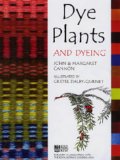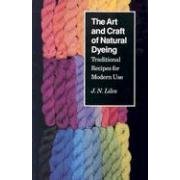Dyeing with Oregon Grapes (Mahonia Aquifolium)
—ADVERTISEMENTS—
Books About Natural Dyes
by John & Margaret Cannon
Dye Plants and Dyeing

The Art and Craft
of Natural Dyeing:
Traditional Recipes for Modern Use
by Jim Liles

The Dyer's Garden
by Rita Buchanan


The Complete Guide to Natural Dyeing
by Eva Lambert

Country or region: USA
Message: I'm a freelance writer working on an assignment on Oregon Grapes (Mahonia Aquifolium). Numerous sources say the inner bark and roots of this plant have been used for a yellow dye and the berries for a blue dye. I'm trying to find someone who has actually worked with Oregon Grape-derived dyes and can tell me his/her experiences. Thank you.
1 peck chopped hollygrape root. [one peck equals two gallons]
Mordant the wool with alum (p. 6). Soak the chopped root over- night in water to cover. In the morning boil for 2 hours, strain, and add enough water to make 4 to 4% gallons for the dye bath. Immerse the yarn or cloth thoroughly rinsed and squeezed out of water and boil for 30 minutes. Rinse and dry. Tan.—For each pound of wool mordanted with alum, allow:
1 peck chopped hollygrape root.
1/6 ounce potassium dichromate.
1/6 ounce acetic acid, or 6 to 7 tablespoons vinegar.
Mordant the wool with alum (p. 6) and dye as directed above. Without rinsing put into a boiling bath of the potassium dichromate and acetic acid, stir carefully, and boil 10 minutes longer. Rinse and dry."
(Please help support this web site. Thank you.)
Posted: Tuesday - March 20, 2012 at 10:17 AM All About Hand Dyeing Q&A Previous Next
Follow this blog on twitter here.
- Top of this blog -
- FAQ -
- The Dye Forum -
- How to Tie Dye - How to Batik -
- Books - Toys - Plants -
More in this category:
- -
Follow this blog on twitter here.
Calendar
Search
Categories
- about dyes
- batik
- big projects
- business of dyeing
- changing color of clothing
- chemistry of dyeing
- color mixing
- disasters and problems
- discharge (bleach) dyeing
- dye & fiber choice
- dye application
- dye safety
- dyeing acrylic
- dyeing furniture
- dyeing nylon
- dyeing objects
- dyeing polyester
- finding a dyer
- fixing dye
- immersion or vat dyeing
- miscellaneous
- natural dyes
- pigments and fabric paint
- rainbow dyeing
- removing dye
- satin can be any fiber
- schoolwork
- screen prints & dye
- they want to sell us dyes
- tie dye parties
- tie-dyeing, resists, shibori
- washing out after dyeing
- where to get dyes and supplies
Archives
XML/RSS Feed
Statistics
All About Hand Dyeing Q&A: 2223
about dyes: 176
batik: 57
big projects: 12
business of dyeing: 8
changing color of clothing: 357
chemistry of dyeing: 105
color mixing: 53
disasters and problems: 68
discharge (bleach) dyeing : 32
dye & fiber choice: 209
dye application: 72
dye safety: 49
dyeing acrylic: 2
dyeing furniture: 49
dyeing nylon: 46
dyeing objects: 33
dyeing polyester: 125
finding a dyer: 50
fixing dye: 106
immersion or vat dyeing: 20
miscellaneous: 127
natural dyes: 30
pigments and fabric paint: 48
rainbow dyeing: 11
removing dye: 63
satin can be any fiber: 9
schoolwork: 43
screen prints & dye: 12
they want to sell us dyes: 2
tie dye parties: 23
tie-dyeing, resists, shibori: 56
washing out after dyeing: 32
where to get dyes and supplies: 133
– ADVERTISEMENTS –
Tie-dye kits make great gifts!
Total entries in this category:
Published On: Aug 29, 2012 02:49 PM

 Syndicate this site
Syndicate this site